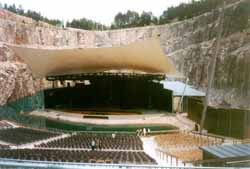
![]()
|
Index
•
|
|
Welcome
•
|
|
21st Century•
The Future |
|
World
Travel•
Destinations |
|
Reviews•
Books & Film |
|
Dreamscapes•
Original Fiction |
|
Opinion
& Lifestyle •
Politics & Living |
|
Film
Space •
Movies in depth |
|
Kid's
Books •
Reviews & stories |
|
|
|
|
The International Writers Magazine: Sweden
DALHALLA – OPERA IN A QUARRY.
• Eva Bell.
About 300 kms northwest of Stockholm is the beautiful region of Dalarna, spread out all around Lake Siljan, The neat timber cottages built in the old Dalecarlian style, the lawns in verdant green, meadows covered with wild flowers, reaching almost down to the water’s edge, were so refreshing. We motored down to Rattvik, where we were promised a very unusual treat.
An old limestone quarry had been abandoned in 1990 due to heavy flooding from underground springs. The quarrying had left what looked like a natural amphitheatre of incredible dimensions, 400 x 175 x 65 metres. In its depths was a green lake. The colour was due to calcium carbonate reflecting the sunlight.
It might have remained abandoned but for a stroke of luck.
At Whitsun in 1991, Margarita Dellefors an operatic singer was taking a stroll in that area when she chanced upon this quarry. The lady stood on the brink of the quarry and belted out a song. She found that the acoustics were superb. A vision was born. She thought this would be an ideal place for staging summer festivals. It helped that she was working for the Ministry of Culture in Stockholm.
The amphitheatre was opened in 1997, at a cost of 40 million kroner, half the cost of a regular theatre.
The stage is about 600 square metres, and is surrounded on three sides by a green moat. The conductor arrives by boat, to the “pit” of the stage where the musicians are seated. There are no loud speakers because the acoustics are excellent.(65 decibels of sound.) When one person sings or when one instrument plays, the sound effects are best.
At the back of the stage is a black board on which the words of the opera are flashed in Swedish, as most operas are in Italian. The galleries are plain slatted wooden chairs that can seat 4042 people in an area of 227 square metres.
The visual effects are stunning. The rock walls are flooded with lights of many muted colours, and the green lake surrounding the stage adds to its beauty.
On that first evening of the show in 1997, an abridged version of Wagner’s ‘Rigoletto’ was performed by artists of international calibre. It must have been a glorious night to remember. Today artists from all over the world vie with each other for a chance to perform on this largest open air theatre in the world. At the Millennial New Year performance, the seats were packed to capacity, in spite of the biting cold. When Pavorotti sang, it was –10 degrees, with a steady drizzle to make things worse. He wondered aloud whether they had all gone mad to brave such weather.
Dalhalla is a combination of two words Dal and Halla. Dal stands for the town Dalarna, and Halla is from Wagner’s Valhalla. This environment friendly theatre gets its electricity and water from a spring 175 metres below the lowest level of the mine. Most of the employees come from the five surrounding villages, each with a population of about 250.
After bringing us up to date on the history of this unique theatre, our guide gave us a demonstration of the acoustics, by singing snatches from the Wagnerian opera. It was simply great.
The Summer Festival season lasts from 6th June to 1st September. About 26 concerts are held during the season, which are mostly Opera. However, other types of music like Jazz, Ballet or Gospel music are also performed here. But Rock Concerts are strictly not allowed, as security becomes risky.
Tickets for concerts are expensive ranging from 150 to 430 kroner, but guided tours during the day are free.
From central Dalarna, it takes three hours by road to reach this place.
To book: www.dalhalla.se
© Eva Bell April 2007
evabell@vsnl.com
More
Home© Hackwriters 1999-2007
all rights reserved - all comments are the writers' own responsibiltiy - no liability accepted by hackwriters.com or affiliates.
